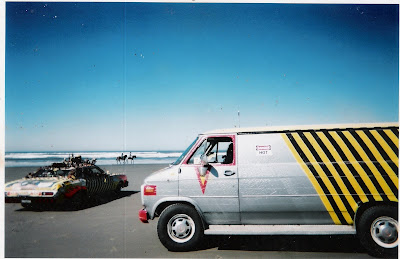Thursday, December 31, 2009
Tuesday, December 29, 2009
Christmas Spirit Manifested by Spray Painting a Limo?

(image credits:wikimedia)
The real Christmas spirit manifested right after Hurricane Katrina in New Orleans in the form of a spray painted limo right after Wal-Mart was looted for spray paint. It seems even in the midst of disaster and bad times, street "artists" found a way to offer peace and season’s greetings. This could very well be the image that best describes the last ten years, that means its time to get your mad max vehicles ready for the next ten.
The Splendorous Form of Noise
The above is a compilation of works by the Swiss artist Zimoun.
1. Funny, one keeps telling oneself, enough of the minimal already, somehow feeling that less is a bore should be embraced, and the outrageously overflowing art of the recent years - appreciated and encouraged. And then, something like this appears, and it's irresistible. We've seen things from this universe before, also on this blog, and yet, the simplicity, yes, the damn purity takes over again.
2. I had a chance, recently, to visit several large factories. There were wonders there that could probably match most of the things on this video. Yet there was one thing they couldn't do: be useless. It's the sheer uselessness of it that gives it the power. We are not attached to anything but the thing. Art as the thing-that-cannot-be-used? Not necessarily, not in some purist sense. Great industrial design is to be cherished. And yet, there is a level of insanity here, of out-of-this-world-ness, that takes us to an exotic land, allowing for the silliest and most delicious connections to be made.
3. Luxury requires waste. A truly luxurious lifestyle is one where perfectly good things get wasted, as if to outplay their natural use and dying away. The true master of luxury seems to be saying her opulence is so great, the very perseverence of things is no match - they lose their original function and only exist to the extent they are participating in this out-of-this-world-ness of luxury.
You know what I'm aiming at? Here's the hypothesis:
4. This, this minimalist joyful pleasure-making, is the true luxury. Not the apparent richness of the new complexities. In the world of useless purity, everything only serves the joy of simple aesthetic pleasure. More complex works are not quite like that - they have an inner game to play. The elements enter a dialogue, start relations and societies, with their conflicts and functions and disruptions. Here, there is only the ping of a shot of pleasure. This engine moves nothing. It is here to make me smile (or bring inspiration, or scare) - and I turn it off as soon as I have. And don't be mistaken - if I had one of those and got bored with and could afford it, it would go to waste.
4a. Ah, you might say, but the truly great art is one we don't get bored with. Possibly. Yet how often do we actually go back to contemplate (not just think about or admire or analyze) a work of contemporary "minimalist" art? Does it mean it's because it's not that great? What if it's about something else? What if it is an element of luxury, a game we play with ourselves, to feel the exquisite taste of the sophisticated dish, and then to ditch it as soon as we're fed up? It wouldn't be a question of bluff, of fakeness, of shallowness. It would be a question of use. Of why we crave it, this new. Of how we make it useful after all.
 David Foldvari, Wrestler
David Foldvari, Wrestler
(via)
ON THE DIFFICULTY OF DRAWING WOMEN'S FACES
But as the astute Goethe noted, "Nothing is harder to take than a succession of fair days," and every once in a while (usually at the end of a year in which one hasn't met his full quota of foolhardy behavior) a person will deliberately risk life and limb by exploring the significance of those differences out loud.
It is in that spirit that I set out today to consider why it is more difficult to draw women's faces than men's faces.
Artists quickly learn that men's faces are easier to draw because men have bone structures and muscle groupings that are more pronounced than women's. Male heads are generally more blocky and angular; they tend to have stronger jaws, square chins and prominent brows. These features provide artists with easy opportunities to employ distinctive lines, strong shadows and recognizable shapes to achieve a resemblance.

From the Famous Artists School course materials, "Constructing the Head and Hands."
Women's faces, on the other hand, tend to be smoother and softer, with rounder shapes and subtler, more delicate features which require greater restraint.
Another difference that makes men's faces easier to draw is that, "as the man matures he develops larger, deeper wrinkles while the woman develops smaller ones because her skin is finer textured and her bones and muscles are less prominent." If an artist wants to capture a likeness using lines, it is much easier if the subject has lines that were already mapped by nature.
Note in the following examples how men's sharper angles, prominent facial muscles and deeper wrinkles have provided artists with more tools for describing a form.

Here, Mort Drucker sculpts the male face, but on the woman's face he stops with just the outline. Her features can't be rendered effectively using the same kind of approach, and must be implied instead.

Here, Leonard Starr puts a strong chin, nose, cheekbones and brow on the man (while making it clear from facial expressions that the woman has the stronger mind).

Here, Norman Lindsay tries to deal with the difference between men and women by using small dots to convey the woman's features, while using lines for the man.
The special challenge of a woman's face is that it compels artists to describe subtler forms with fewer lines and less obvious shapes, depriving artists of some of the most fundamental tools in their tool kit. In the following image, Leonard Starr limits himself to little more than an outline of the face but nevertheless gives us important information about the contour of her cheek simply by leaning more heavily on his brush on portions of the right side of her face.

So what is the larger significance of these observations about the differences in drawing the faces of men and women?
Part of the magical power of drawing is that it can lead us unexpectedly to larger truths. The principles we encounter in drawing the faces of men and women often seem rooted in fundamental realities about the sexes:
Like their faces, men's personalities are more easily reduced to a line than women's personalities. Like their facial features, men tend to be more obvious than women. (Artists frequently bear witness to such triumphs of physiognomy!)
Women, on the other hand, are sometimes best understood implicitly and indirectly; the discipline of describing form without heavy reliance on lines requires subtlety, appreciation and restraint but you can sometimes achieve a far better likeness that way.
Regardless of whether these larger principles resonate with you, I am sure we can all agree that if an artist lacks the patience for the complexity of ambiguity, you can't compensate for that lack by substituting more (or more emphatic) lines of the type that you use for a man's face. In such situations, "more" will invariably turn out to be "less."
Saturday, December 26, 2009
Wishing you aesthetic pleasure
 Gabriel Cornelius von Max, Monkeys as Judges of Art (1840)
Gabriel Cornelius von Max, Monkeys as Judges of Art (1840)(I'm the small one watching the work, the one in the middle, whose profile can be seen behind the bent knee)
Thursday, December 24, 2009
Argentine Bus Protester Gets Graffiti Makeover

Argentine Bus Before

via
I found this before and after shot of a camper van on the Plaza delos Dos Congresos parked near the Argentine National Congress as a form of protest by the owner about something or rather. Some months later the bus gets a fantastic makeover by a young French artist named Louis D’Anjou a.k.a 'GROLOU, who thought the bus needed a facelift. I think the new look is a vast improvement,nice work.
Techno Jeep Music Art Car by Julian Smith

This amazing Techno Jeep video has got to be the first art car music piece I have ever seen and it came from Julian Smith.tv. Julian and his friends use ACTUAL sounds from a Jeep by mics to pick up the various sound elements. The sounds are then fed into sound board, recorded and then looped back to create the techno sound in this video (I think that's how it works). It took about two weeks to rehearsal and 7 hours of filming resulting in a video worthy of mention here on art car central
Tuesday, December 22, 2009
Monday, December 21, 2009
Earn your money


 The Minimum Wage Machine (work in progress), by Blake Fall-Conroy
The Minimum Wage Machine (work in progress), by Blake Fall-ConroyThe minimum wage machine allows anybody to work for minimum wage. Turning the crank will yield one penny every 5.04 seconds, for $7.15 an hour (NY state minimum wage). If the participant stops turning the crank, they stop receiving money. The machine's mechanism and electronics are powered by the hand crank, and pennies are stored in a plexiglas box.
Contrary to some other art experiments on work (I'm thinking of some of Santiago Sierra's early projects, but had I any memory, I'm sure a dozen other works would come to my mind), this, here, is not about objectifying labor. It takes the paradox of work-as-product in a somewhat different direction. If there is a minimum wage, any job should be paid the minimum wage. So turning the handle should actually always give you this result.
You can read a technical description of how it was constructed (didn't understand half of it) here.
HENRY PATRICK RALEIGH (1880-1944)

The illustrator Henry Raleigh started and ended life in poverty and despair. But in between, he spent decades painting high society pictures and living the opulent life of one of the best paid illustrators in the country.

Born into a broken and destitute family, Raleigh began working at age 9 to support his mother and sisters. By the age of 12, he quit school altogether and found work on the docks of San Francisco, processing shipments of coffee beans from South America. Here, rough sailors and roustabouts filled his head with colorful and bawdy stories of life in far off places. At age 17, his knack for drawing landed him a job as a newspaper artist for the San Francisco Bulletin where he was assigned to some of the most seamy and gruesome aspects of the city, including executions, fires and fatal accidents. He later recalled learning a lot about human anatomy at the morgue sketching "promising looking corpses."
Raleigh's work soon attracted the attention of art directors and publishers who offered him better assignments. He moved to New York where he gradually progressed from newspapers to top magazines such as Vanity Fair, Harper's Bazaar, Colliers and Saturday Evening Post. Surprisingly, his trademark became his pictures of glittering parties and fashionable society life. He was sought after by some of the greatest writers of his day, including F. Scott Fitzgerald, who wrote a fan letter saying, "Honestly, I think they're the best illustrations I've ever seen!"
At his peak, Raleigh was able to make enough money from just three or four months of work to enable him to spend the balance of the year traveling abroad with family and friends. American Artist magazine later wrote:
With distinction came affluence. In his best years his annual take was in the neighborhood of $100,000. Considering the then value of the dollar and the relatively insignificant tax on income, Raleigh probably had more cash in hand at the end of the year than any other illustrator before or since.But Raleigh also spent money freely. He gave away thousands of dollars to friends, traveled lavishly, maintained a yacht, owned a mansion and kept a large studio in downtown Manhattan.
Unfortunately, styles changed (along with social values and taste in art) and his work dried up. Raleigh could not adapt; bankrupt and bitter, he committed suicide in 1944 by jumping out of the window of a sleazy hotel in Times Square.
One of the things that I find most interesting about Raleigh's approach is the way he often surrounds a core of careful drawing with a flurry of loose scribbles, repetitive lines and stray marks. My initial reaction to his work was frustration with what seemed like a lot of superfluous, fluttery lines. But I learned more about his objectives when I read a 1923 interview:
the most beautiful picture is one which the observer is left free to complete for himself. The illustrator should be able to select the essential elements in any subject which will convey to the layman the entire scene in the simplest and most direct way, avoiding mere details which tend to cause either monotony or confusion.And indeed, the focal point of Raleigh's illustration often consists of a few sensitive, well placed lines to define the "essential elements" (proving he can indeed draw), encircled by increasingly loose and broad marks that create a general tone but offer few competing details.

Note how quickly Raleigh retreats from his careful handling of the central figures to the stray, wispy lines of the background couple (above) or the loose treatment of the balustrade (below).

Similarly, in the following illustration...

contrast Raleigh's careful treatment of the exchange between the two main characters:

With the loose, flowing treatment of the rest of the picture:

The majority of this picture seems to be made up of the chaos and scribbles you might expect from an abstract painter:

Finally, in the following detail, contrast the delicate linework in the faces at the top of the picture with the broad, rough treatment of the balance of the image:

I admire the fluid, seemingly effortless way that Raleigh was able to combine two very disparate ingredients in his art. If he had been able to accomplish the same thing with the disparate sides of his life, he might have had a chance at happiness.
Sunday, December 20, 2009
Wink

UPDATE: It is The Cyclops by Jaime Pitarch (2002)
Thank you Claudia!
Friday, December 18, 2009
Does beauty make sense?
And does beauty differ dependent on categories? After all, we do watch differently than we listen. And when we watch, the pleasure of, say, seeing a beautiful feature film is quite different from the pleasure of seeing a piece of video art. And although of course the merging and the postmodernism and the over-all mishmash exists in discourse, the categories are still quite strong, our (my) attitudes vary tremendously depending on what I'm watching. It's a tricky area, tagging. But the fact that it's tricky should only encourage to explore, no?
Between from Via Grafik on Vimeo.
(via)
Dangerous Duct Tape Van on the Loose

I was sent this duct tape art van the other day from my friend mark, an engineer with a duct tape talent and here is what he said;
I am an art car artist and went to the westfest and Seattle Artcar Blowout several times. The duck tape van was created because of inspiring friends in Eugene, Oregon. These early forrays into art have opened new doors for me and enriched my life. As an engineer, duck tape was always there but never appreciated. Discovering the wacky, wonderful world of art cars released my spirit and let me fly.Thanks Mark and while I was at it I found a few more duct tape van jobs created by folks gifted in other areas.
Window Repair Duct Tape Van Job

Rust Repair Duct Tape Van Job

False Advertising Duct Tape Van Job

Thursday, December 17, 2009
CB Radio King Rules the Air with $25,000 Of Communications Gear In A $500 Car




Via Jalopnik
Holy Cow!!!!!!!!!!!This $500 Dodge for sale is covered with $25,000 Of Communications Gear for every conceivable band (FM/UHF/HF/VHF/SPACEMAN). It deserves a mention first because of the obsessive nature to cover ever conceivable service with multiple objects of the same genre and second because of the stunning overall visual effect it creates. The equipment covers and amazing array of technologies with a ton of handheld 144 MHz radios and capable of listening to every police/fire/ems/military channel in the world. Don't forget there is also a laptop computer that probably covers cellular or satellite communication as well. Most art cars have CB radios when traveling together in groups and this guy would be more than welcome to join our art car party, providing he help out with those of us who are CB "challenged". You my friend are the CB radio King!!!!!
Tuesday, December 15, 2009
Omniphilia

 The first image seems the most banal. But we'll get back to it.
The first image seems the most banal. But we'll get back to it.The second is clearly far from innocent. Or rather, it is its absolute innocence that brings the tension.
Just one more innocent painting to keep you off-guard...

And here we go:

 Most of Melissa Steckbauer's spicier pictures are somewhere along the lines of the above. They are people in erotic/sexual situations with animals, realistic or mythical ones. Now, how in the world can she include the first painting you see here (the bear-girl) in the same series, Animalia, as the ones you've just seen?
Most of Melissa Steckbauer's spicier pictures are somewhere along the lines of the above. They are people in erotic/sexual situations with animals, realistic or mythical ones. Now, how in the world can she include the first painting you see here (the bear-girl) in the same series, Animalia, as the ones you've just seen?That is precisely what gives the series such power. They demistify us by including us in the myth. This human animal becomes a being of flesh. Of flesh and myth. This teddy bear is the same girl that's having sex with the dog, moving away from the otherness as it penetrates her. Better: she and the beast are one flesh. They are no different, as if in peace with their unbearable similarity. Look at the man with the bear. What is this? A killing? Could it possibly be a hug? No, it is a hug, be it intended or not. It is flesh, it is warm and cuddly. And foreign. Although harmonious - Steckenbauer insists that for her the crucial issue in terms of eroticism is ethics, which she seems to oppose to a set of taboos. But is there really no taboo? No hidden, dangerous zone? To the contrary, the further she goes, the more mysterious and ambivalent the universe. What is this animal, and how does one distinguish it from oneself?



In the interview at the end of this post, Steckbauer talks about her appreciation for "meat in the painting". And for softness and gentleness. And one of my favorite works of hers combines these two. It is somewhat different from the others, reminding me of Man Ray, maybe. What can we do, it says, what can we do if this is the touch of flesh, the touch that seems to go through my body, to immobilize us as it multiplies the members and gets us way out into oblivion, a communication made ambiguous, an identity lost, or repainted, or foresaken, for the sake of what, of what, oh don't ask me, enjoy.

PS: I dedicate this post to the memory of my aunt, whom I first had the chance to speak to when I was 17. We spoke on the phone (she lived in another country). Her very first words to me were: "Hello young man! How are you? How is your sex life?"
(via)
Monday, December 14, 2009
Fozzie Bear's Psychedelic Art Car

Make/Model: 1951 Studebaker Commander via
We got The Muppet Movie today from Netflix and it so happened that there was an art car in it. This 1951 Studebaker Commander was and old beat up hand-me-down from Fozzie’s uncle with a custom psychedelic paint job courtesy of Dr. Teeth and crew.
ART TO KILL SNAKES WITH
That definition has served me pretty well in the past. But recently, as conceptual art has become more complex, I have wondered whether Williams' definition requires additional refinement.
In each of the following three examples of conceptual art, an artist takes another artist's work and modifies it:
1. An erased drawing:

Artist Robert Rauschenberg famously took a drawing by DeKooning and erased it as his work of art.
2. A photograph of a photograph:

Artist Sherrie Levine photographed the work of another photographer, Walker Evans, and called her art, "After Walker Evans." According to the Metropolitan Museum of Art's website, her copies of Evans' photos were "a landmark of postmodernism" as well as "a critique of the commodification of art, and an elegy on the death of modernism. Far from a high-concept cheap shot, Levine's works from this series tell the story of our perpetually dashed hopes to create meaning, the inability to recapture the past, and our own lost illusions."
3. Exposing another artist's posters to light:

Illustrator Steve Brodner recently flagged this work by feminist artist Barb Choit, whose art consists of taking posters by illustrator Patrick Nagel and exposing them to light so they fade. The New York Times reported on the opening of her show at a Manhattan gallery: "Ms. Choit buys the posters online and then partly fades them, using a tanning bed, lamps and other skin-darkening products. Then she translates them into ink-jet prints and attaches them to clear plastic panels, creating tension between the risible imagery and slick format and her own sly conceptualism."All three works are primarily conceptual, but I like Rauschenberg's best. His concept seems the least pretentious of the three and he at least leaves us with an object, made by human hand, with some nice texture and design to it. But between the three of them, there is enough "sly postmodern conceptualism" to choke a full grown python.
So what about Williams' definition of art? Does this mean it is obsolete?
I don't know enough about the definition of art to say that these three works don't qualify, but I feel confident I know enough to say when art is crummy. Ultimately this may be the more relevant judgment.
I agree that one can play interesting conceptual games with the theories advanced above, but personally I find that artistic principles are not at their best when hovering in mid air as concepts. They need to be embodied in something both perishable and difficult in order to achieve their fullest potential.
That is why conceptual art , which does not exist on a sphere where it is forced to compromise and commit, is inherently less interesting.
Sunday, December 13, 2009
Munching Sweets


From the Towers
by Heather McHugh
Insanity is not a want of reason.
It is reason's overgrowth, a calculating kudzu.
Explaining why, in two-ton manifesti, thinkers sally forth
with testaments and pipe bombs. Heaven help us:
spare us all your meaningful designs. Shine down or
shower forth, but (for the earthling's sake) ignore
all prayers followed by against, or for. Teach us to bear
life's senselessness, our insignificance, and more;
let's call that sanity. The terrifying prospect isn't some
escapist with a novel, fond of comfort, munching sweets—
it is the busy hermeneut, so serious he's sour, intent on making
meaning of us all, and bursting from the towers to the streets.
Paintings by Hegyusz.


